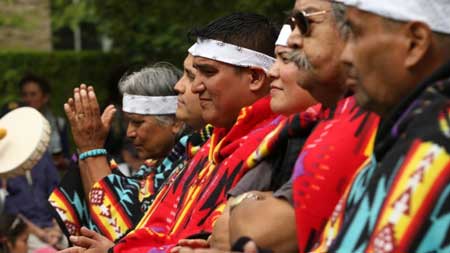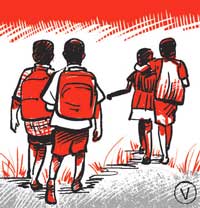
(Chad Hipolito/file photo/The Canadian Press)
To read, download or print the entire PDF-document (10 MB), click here >>
STATEMENT OF VALUES
“We want education to provide the setting in which our children can develop the fundamental attitudes and values which have an honored place in Indian tradition and culture. The values that we want to pass on to our children, values which make our people a great race, are not written in any book. They are found in our history, in our legends and in the culture. We believe that if an Indian child is fully aware of the important Indian values he will have reason to be proud of our race and of himself as an Indian.
We want the behavior of our children to be shaped by those values which are most esteemed in our culture. When our children come to school, they have already developed certain attitudes and habits that are based on experiences in the family. School programs that are influenced by these values respect cultural priority and are an extension of the education which parents give children from their first years. These early lessons emphasize attitudes of:
self-reliance,
respect for personal freedom,
generosity,
respect for nature, and
wisdom.
All of these have a special place in the Indian way of life.While these values can be understood and interpreted in different ways by different cultures, it is very important that Indian children have a chance to develop a value system which is compatible with Indian culture. The gap between our people and those who have chosen, often gladly, to join us as residents of this beautiful and bountiful country, is vast when it comes to mutual understanding and appreciation of differences. To overcome this, it is essential that Canadian children of every racial origin have the opportunity during their school days to learn about the history, customs and culture of this country’s original inhabitants and first citizens. We propose that education authorities, especially those in Ministries of Education, should provide for this in the curricula and texts which are chosen for use in Canadian schools.” 1
1 National Indian Brotherhood/Assembly of First Nations, Indian Control of Indian Education:
Policy Paper, 1972 at pg. 2. ***“Unless a child learns about the forces which shape him: the history of his people, their values and customs, their language, he will never really know himself or his potential as a human being. Indian culture and values have a unique place in the history of mankind. The Indian child who learns about his heritage will be proud of it. The lessons he learns in school, his whole school experience, should reinforce & contribute to the image he has of himself as an Indian.” – ICIE 1972 POLICY PAPER***
The Indian Control of Indian Education 1972 (ICIE 1972) policy articulated a statement of values which is as true today as it was at its inception. The National Indian Brotherhood (hereinafter Assembly of First Nations (AFN)) adopted the policy paper “Indian Control of Indian Education” in 1972 (Appendix I). The ICIE 1972 policy was affirmed by then Minister of Indian Affairs, Jean Chrétien, in 1973. The full spirit and intent of the ICIE 1972 policy, however, has never been supported in a meaningful manner. Successive federal governments have consistently failed to provide the necessary support to fully implement the comprehensive First Nations learning environments and systems envisioned by First Nations that would lead to an overall improvement in learning outcomes. […]
***
PREAMBLE
Prior to the arrival of Europeans, First Nations had full control and access to all of the land and resources within their traditional territories. After European settlement and expansion, First Nations were forced onto small land parcels called reserves and were deprived of exercising their rights to their lands, resources, jurisdiction, culture and governance.
Canada’s ongoing colonial processes continue to have detrimental impacts on First Nations peoples. Being forced to move from self-sufficiency to dependency has undermined the individual, family, community and national well-being of First Nations. It has also adversely affected our relationships between peoples and with the natural world.
Canada’s assimilationist and racist policies from the residential school era failed First Nations peoples. Misguided government actions have also devastated the socio-economic well being of First Nations children, families and communities. […]
***
FIRST NATIONS SUCCESSES
The ICIE 1972 policy also led to First Nations autonomously developing and creating First Nations schools. Today, there are 518 on-reserve schools that are responsible for delivering programs and services for students from Kindergarten to grade 12 using First Nations pedagogies. Many of these First Nations controlled schools are led by First Nation principals and administrators with qualified and certified First Nations teachers. The majority of these schools provide local language and culture programs. Sixty percent of all First Nations students, approximately 70,000 individuals, attend First Nations elementary and secondary schools. In many communities, there are also locally controlled early childhood education and preschool programs that feed into the K-12 programs. […]
Through the efforts of First Nations educators and leaders, courses and curricula delivered in First Nation controlled schools and institutes are beginning to reflect the perspectives and foundations of First Nations traditions and worldviews. These important changes have led to increased numbers of relevant education methodologies that strengthen First Nations identities and dramatically improve opportunities for success. Many of these developments have been shared with provincial jurisdictions. […]
***
FIRST NATIONS LEARNING SYSTEMS First Nations’ vision of lifelong learning encompasses learning from the pre-natal to Elder level and includes systems that are holistic, high quality, linguistic and culturally-based.
First Nations lifelong learning systems must be founded on First Nations languages, cultures, histories, philosophies, worldviews and values, as these are the heart of our identity.
All First Nations learners require a wide variety of opportunities that will nurture their learning and allow them to acquire the necessary skills and knowledge to actively and positively participate in, and contribute to, their families, clans, Nations, society and the global community. […]
***
“It is generally accepted that preschool and primary school classes should be taught in the language of the community. Transition to English or French as a second language should be introduced only after the child has a strong grasp of his own language. The time schedule for this language program has been determined to be from four to five years duration. Following this time span, adjustment and adaptation to other languages and unfamiliar cultural milieu are greatly enhanced.” – “LANGUAGE OF INSTRUCTION”, INDIAN CONTROL OF INDIAN EDUCATION, 1972
***
CONCLUSION
The Indian Control of Indian Education 1972 policy framework emerged from a time when First Nations education was in crisis and real change was necessary. The result was a number of successes by First Nations in First Nations education, despite the lack of full implementation of the ICIE 1972 policy by governments in Canada. The First Nations Control of First Nations Education 2010 policy framework is emerging in a time of a new crisis. It is a call to action.
First Nations Control of First Nations Education 2010 is a reflection of a First Nations vision for real, meaningful and lasting change. Once again, First Nations are initiating constructive, pragmatic and innovative proposals for advancement. In the spirit of reconciliation, it is now time for federal, provincial and territorial governments to equal the commitment and leadership of First Nations.
Source: First Nations Control of First Nations Education
URL: http://www.afn.ca/uploads/files/education/3._2010_july_afn_first_nations_control_of_first_nations_education_final_eng.pdf
Date Visited: 21 June 2020
[Bold typeface added above for emphasis]

Timeline: Key moments in the struggle over First Nations schooling policy
The Canadian Press, Published Sunday, July 21, 2013 7:15AM EDT
Education policy has long been a source of tension between the federal government and First Nations, from the painful legacy of residential schools to the current debate over the upcoming First Nation Education Act.
Source: Timeline: Key moments in the struggle over First Nations schooling policy | CTV News
Address : https://www.ctvnews.ca/canada/timeline-key-moments-in-the-struggle-over-first-nations-schooling-policy-1.1376568
Date Visited: 21 June 2020
- Ekalavya* Residential School Scheme (EMR): a network of boarding schools where tribal children are to be educated in accordance with rules and syllabi provided by the government; such schools are being designated as “Eklavya Model Residential School (EMR)” with the objective of empowering students “to be change agent, beginning in their school, in their homes, in their village and finally in a large context.” – Government Guidelines 2010 | Backup >>
- Residential School and Ashram School
In some regions there are similar “Residential Schools” and “Ashram Schools” for tribal children, as in Tripura where they are managed by a society called “Tripura Tribal Welfare Residential Educational Institutions Society (TTWREIS)” – Tribal Welfare Department, Government of Tripura - Factory schools “exist to turn tribal and indigenous children – who have their own language and culture – into compliant workers-of-the-future. The world’s largest Factory School stated that it turns ‘Tax consumers into tax payers, liabilities into assets’.” – survivalinternational.org/factoryschools | Learn more >>
Up-to-date information about these and related issues: Safe custom search engine >>
* Ekalavya (Eklavya, Eklabya): the name of a legendary archer prodigy “who, being a Nishada [Sanskrit Niṣāda, “tribal, hunter, mountaineer, degraded person, outcast”], had to give his thumb as a fee to the brahmin guru thus terminating his skill as an archer.” – Romila Thapar (“The epic of the Bharatas”) | Read the full paper here | Backup download link (pdf) >>
Note: “Forcibly transferring children of the group to another group” amounts to genocide, which the United Nations Office on Genocide Prevention defines as “acts committed with intent to destroy, in whole or in part, a national, ethnical, racial or religious group” (Article II, d & e)
Learn more about Childrens rights: UNICEF India | Ekalavya (Eklavya, Eklabya), EMR & Factory schools | Rights of Indigenous Peoples >>
Related posts
See also
CBC Unreserved (Canada) radio space for indigenous community, culture, and conversation
eLearning: Center for World Indigenous Studies
Indigenous people are at the forefront of the struggle to save the planet
Internet Archive | Archive.org
People’s Archive of Rural India (PARI) | RuralIndiaOnline.org
Recovering tribal culture from the misrepresentation of mainstream media
Storytelling | Success stories
